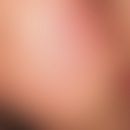DefinitionThis section has been translated automatically.
Surgical therapy procedure for covering defects by inserting free full-thickness skin grafts.
General informationThis section has been translated automatically.
- When suture flaps are not available or not feasible, the second choice for defect coverage should be a full-thickness skin graft, if possible. The full-thickness skin graft has a similar quality to a local flap. The tendency to shrink is low. For the selection of the donor site, it must be taken into account that the harvested full-thickness skin retains the characteristics of its donor site, e.g. hairiness. Full-thickness skin grafts primarily require a well perfused recipient site. Bare bone or cartilage without perichondrium will not accept full-thickness skin. Good intraoperative hemostasis is eminently important because a hematoma can easily separate the graft from the bed. Hemostasis by electrocautery can leave necrotic tissue and cause adverse inflammatory reactions. To create a well-vascularized wound area, basic vascular anatomic structures such as periosteum and perichondrium must be preserved.
- Excision of the donor flap is usually performed in a spindle shape followed by primary wound closure. The underside of the flap is then carefully freed from the subcutaneous fatty tissue.
- Donor regions:
- Retroauricular region: The back of the auricle and the adjacent hairless region above the mastoid is suitable as donor region for the facial area.
- Preauricular zone (see full-thickness skin graft, preauricular): The skin in front of the tragus, which is often present in excess, is particularly suitable for covering the wound bed in areas of cartilage- or bone-supported tissue, e.g. nose and ear, but also at the inner corner of the eyelid (Fig. 1 a, b).
- Upper eyelid: In adults, excess skin is often found in the upper eyelid region that is usable for defect coverage in the eyelid region.
- Supraclavicular and neck region: The skin is similar to that of the retroauricular region.
- Articular skin: It is similarly suitable for transplants in the face as the supraclavicular skin, a disadvantage being an increased tendency to hypertrophy (Fig. 2).
- Thigh and abdominal region: Because of the relatively thick dermis layers, these areas are particularly recommended for transplants to the palms of the hands and soles of the feet.
- Full-thickness skin grafts are less suitable for the cheek and perioral regions. If, for example, a graft bridges areas of stronger mimic stress and a skin zone hardly activated by muscle movement, necrosis, graft shrinkage (Fig. 3) and tissue hypertrophy are to be expected.
- If alternative methods of defect coverage are not feasible, more extensive grafts for the facial area can be taken in a spindle shape from the cervical, supraclavicular or from the inner side of the upper arm. For other recipient areas, full-thickness skin flaps of up to approximately 150 cm2 are preferred from the groin or abdominal zone. Depending on size requirements, mesh flaps can also be created using stitch perforation or mesh graft dermatome.
LiteratureThis section has been translated automatically.
- Breuninger H, wooden shoe J (1994) The complete histological presentation of the cut edges of a skin tumor excise (3-D histology) in one sectional plane using the "flounder technique". Nude Dermatol 20: 7-10
- Diem E (1984) Errors and complications of free skin grafts. In: Konz B, Braun-Falco O (ed.) Complications in operative dermatology. Springer, Berlin
- Kurte A, Lange-Ionescu S, Budde J, Frog PJ (1994) Plastic coverage of large skin defects with full skin transplantation from the groin: an underused chance? In: Mahrle G, Schulze HJ, Krieg T (Hrsg) Wundheilung-Wundverschluss, Fortschritte der operativen und onkologischen Dermatologie, Bd.8. Springer, Berlin Heidelberg New York, S 119-120
- Schulz H (1988) Basaliomas and precanceroses of the nose and auricle. Z Allg Med 64: 320-324







